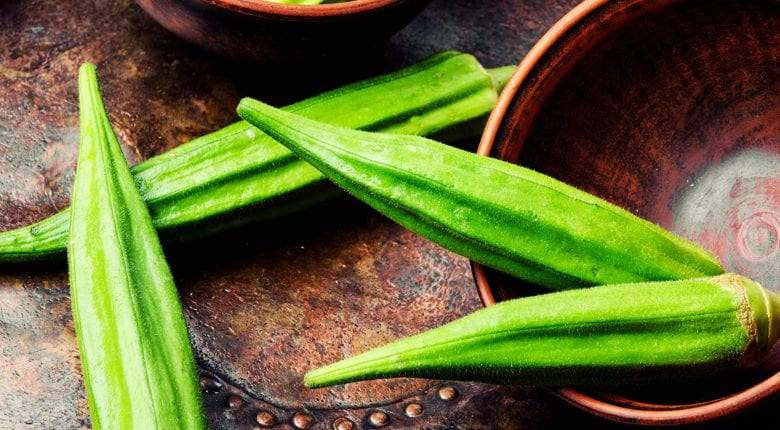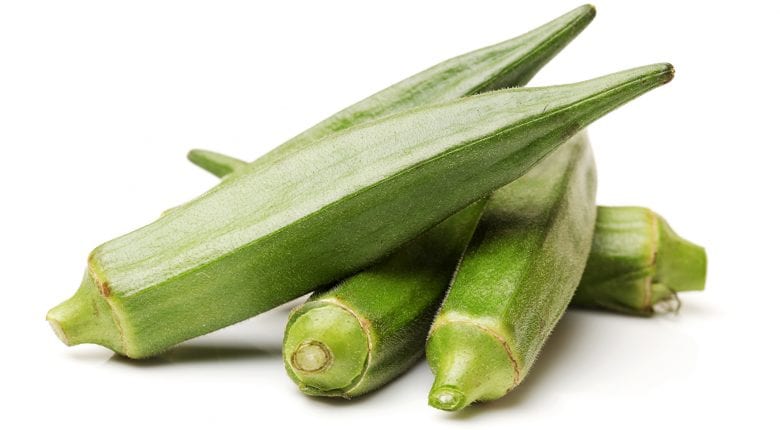Heard of okra? Find out here all you need to know about this fascinating vegetable.
The name ‘okra’ doesn’t make it immediately clear that this is the edible fruit of a species of plant and not some kind of new car model. Even though the vegetable is not particularly well known here in Germany, it is still one of the oldest vegetable plants in the world. Discover how this tropical plant can also enrich our local cuisine and whether it’s possible to grow okra ourselves in our climate.
The mallow plant, also known as gumbo, can grow up to two and a half metres in height and produces a valuable fruit. The capsule fruits which are up to 15 cm in length are green on the outside – more rarely brownish, hairy and are also referred to as Lady’s Finger due to their finger-width tapering shape.
The plant has its origins in the tropics and subtropics of Asia and Africa. This is also where it is primarily cultivated. It is no surprise then that the vegetable is widely used in African and Asian cuisine. We are now also introducing okra to our cuisine.
Go on, try something new using okra
Given their strange appearance, you may well be wondering how to properly prepare okra. Preparation is very simple and leaves you with plenty of options. Wash the okras first and dry them thoroughly. Next, remove the stem base and the front tip. The fruits can be used whole or chopped. They can be used raw, for example, by slicing them up and eating them in salads. Cooking or blanching okra produces a mild, bean-like aroma. Okra can also be steamed or grilled.
Inside the capsules there are pale round seeds and a milky slime. Both are edible and delicious. The seeds taste best roasted or can be used like ground coffee. The slime escapes during cooking. This results in a thickening effect which can be used to thicken soups or sauces. However, the okra does become less firm as a result. If this is not desired, the slime can be prevented from escaping by deep-frying or briefly sautéing the whole fruit.
Okra tastes particularly good in stews or curries and for this reason it is often used in Creole, Caribbean and Indian cuisine. Since its flavour is very mild, tangy herbs and spices with an intense taste are very good for giving the vegetable flavour. For this, add the spices during cooking. If you buy dry okra, it needs to be soaked for one day before it can be used.

Advantages of eating okra – it’s delicious and healthy
Apart from the fact that it can be fun trying out new things in the kitchen, eating okra also brings health benefits. The fruits are full of vitamins and minerals such as vitamins A, C and K as well as calcium, magnesium and iron. This makes okra good for our skin, eyes, immune system and bones. Furthermore, its contains neither saturated fatty acids nor cholesterol and is therefore suitable for a low-fat diet. The low energy content of about 30 kcal/100 g also makes okra ideal for low-calorie diets, for example if weight loss is the aim.
Grow your own – planting okra
For all those vegetable gardeners among us, okra can also really enrich your own vegetable patch. However, we must not forget that the plant’s true home is actually in the tropics. It therefore needs a lot of warmth and sunshine. The best way to provide this in the United Kingdom is in a greenhouse in which it also needs enough space, otherwise its leaves will shade other plants.
You can buy plants in the garden centre or you can grow your okra directly from seed. For this, soak the seeds in warm water before sowing. This speeds up germination. Since okras need a lot of time, it is good to allow them to germinate early (at the beginning of the year) under glass. You can even use a heated propagator for this if you have one. Simply scatter the seeds loosely and cover with a little compost. Once the small plants have grown a bit and there’s no longer any chance of frost, it’s time for the seedlings to go into the greenhouse.

Each plant needs a pot with a diameter of about nine centimetres. Support large plants with a stick. You then need some patience. The fruits form from the end of June and are happy to be harvested from a length of ten centimetres or more. Don’t leave them on the plant for too long, otherwise they lose liquid and develop a tough consistency.
Storing okra correctly
Have you bought or harvested too many? If okra cannot be consumed immediately, the question of freezing arises. In this case freezing is no problem at all! In your Liebherr freezer compartment, okra will keep for up to six months at -18°C without any problems. However, the fruit should be fresh when frozen. Generally speaking, wrinkled okras should no longer be eaten.
The normal fridge compartment is suitable for storage over a few days. Due to their tropical origin, okra do not like the cold temperatures of the BioFresh compartment. Apart from that, nothing now stands in the way of using okra. Have fun with your new discovery!
#okra #capsulefruits #mallowplant #tropical #salads #mild #curry #greenhouse #healthy #freezer